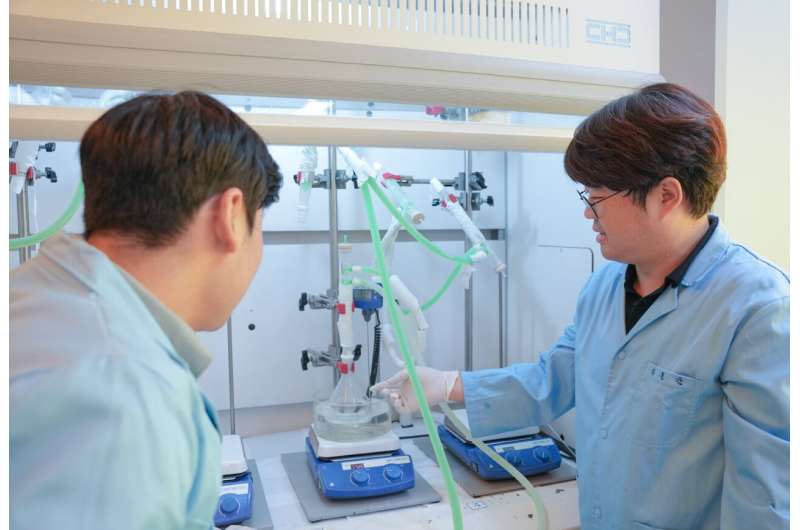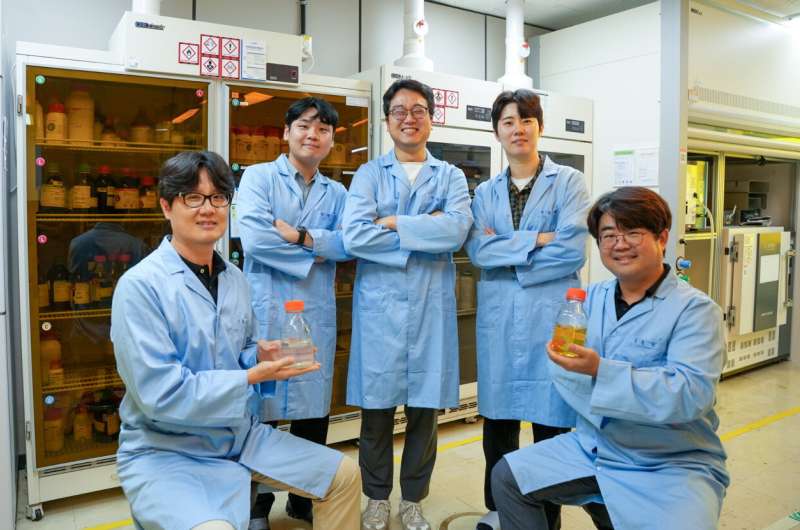This article has been reviewed according to Science X's editorial process and policies. Editors have highlighted the following attributes while ensuring the content's credibility:
fact-checked
peer-reviewed publication
trusted source
proofread
New 'PVDF alternative battery binder' surpasses EU environmental regulations

A research team has developed a technology that enhances the performance of binders—often the 'unsung heroes' in the field of secondary batteries—while using environmentally friendly materials. Their study is published in Advanced Functional Materials.
The researchers were led by Dr. Hyeon-Gyun Im and Dr. Dong Jun Kang from the Insulation Materials Research Center of Korea Electrotechnology Research Institute (KERI), in collaboration with Dr. Jung-keun Yoo from KIST and Professor Jong-soon Kim from Sungkyunkwan University.
The electrode, which has the greatest impact on the performance of secondary batteries, is manufactured by mixing an 'active material' that generates electricity, a 'conductive material' that facilitates the flow of electricity, and a 'binder' with a solvent. The role of the binder is to help the active material and conductive material adhere well to the metal plate (current collector) and to physically stabilize the electrode.
The binder has a relatively small proportion in the electrode, which has led to slower research progress in the past. However, with the increasing demand for high-capacity and high-performance batteries, interest in binders is growing.
Currently, polyvinylidene fluoride (PVDF), a fluoropolymer material, is predominantly used as the binder material for lithium-ion battery positive electrodes. However, PVDF is dominated by some global companies in Japan and Europe, and there have been ongoing functional issues, such as decreased battery stability, associated with its use.
Specifically, PVDF is composed of a very strong carbon-fluorine (C-F) bond and is almost indestructible in nature, earning it the nickname 'zombie compound.' Due to its difficulty in decomposition, it remains in the environment for extended periods and is known to emit significant amounts of greenhouse gases when burned.
Due to these environmental concerns, the European Union (EU) is considering regulating the use of PVDF. Therefore, the development of binder materials that surpass PVDF is extremely urgent.

KERI has addressed this issue by applying 'siloxane' to positive electrode binders. Siloxane is a compound composed of silicon and oxygen, known for its excellent electrical properties and chemical stability.
Dr. Hyeon-Gyun Im and Dr. Dong Jun Kang's team has secured a 'hybrid siloxane resin manufacturing technology' that combines the advantages of both organic and inorganic materials through years of research on nanocomposites. They have also developed molecular structure design and synthesis control technologies applicable to positive electrode binders.
The research team conducted multiple validations by producing full cells using the applied technology. As a result, it was confirmed that the KERI technology exhibits over 1.4 times higher lifespan stability compared to conventional binders with PVDF.
While PVDF is known for its physical and chemical stability and good adhesion properties, it has faced issues such as swelling and unwanted side reactions between internal materials as batteries have progressed toward higher capacity and performance. However, KERI's technology has surpassed these limitations.

The major advantage of this achievement is that it does not contain fluorine, making it environmentally friendly and safe for human health. The new technology is expected to not just avoid the EU's environmental regulations aimed at limiting the use of PVDF but significantly contribute to reducing the reliance on imported positive electrode binders.
Dr. Hyeon-Gyun Im from KERI stated, "While Korea's battery industry is world-class, we currently rely entirely on imports for positive electrode binders due to the lack of specialized technology and companies domestically. Our environmentally friendly binder technology using siloxane has the potential to replace existing PVDF and enhance the safety and lifespan of products requiring high-capacity batteries, such as electric vehicles."
The research team anticipates that this achievement will attract significant interest from the secondary battery industry and plans to identify potential partners to facilitate technology transfer.
Furthermore, they plan to apply the developed technology to dry positive electrode binder materials and continue research to extend its use to various areas, including zinc batteries and sodium batteries.
More information: Junho Jang et al, A Fluorine‐Free Binder with Organic–Inorganic Crosslinked Networks Enabling Structural Stability of Ni‐Rich Layered Cathodes in Lithium‐Ion Batteries, Advanced Functional Materials (2024). DOI: 10.1002/adfm.202410866

















